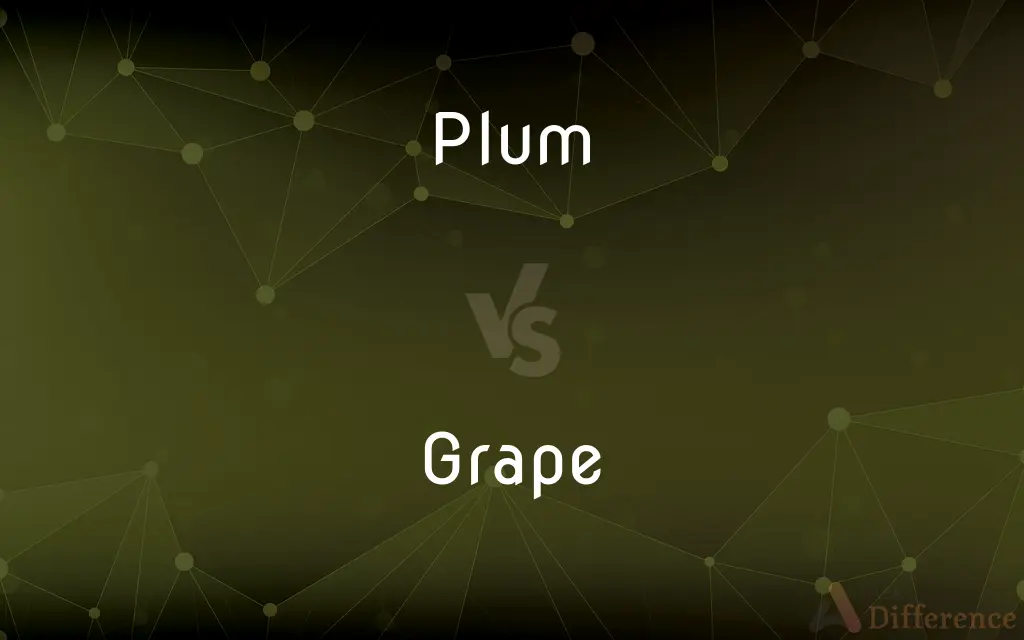Plum vs. Grape — What's the Difference?
By Tayyaba Rehman & Fiza Rafique — Updated on April 1, 2024
Plum is a larger, soft fruit with a single large pit, known for its sweet and tart flavors, whereas grape is smaller, with a smooth skin and can be eaten raw or used to make wine.

Difference Between Plum and Grape
Table of Contents
ADVERTISEMENT
Key Differences
Plums are stone fruits, characterized by their large pits and juicy flesh, which can range from sweet to tart. They come in various colors, including purple, red, and yellow. Whereas grapes are berry fruits, smaller in size, with a smooth, firm skin and a sweet, sometimes tart, flesh. They are typically green, red, or black.
Plums have a diverse range of varieties, each with its unique taste and texture, making them versatile in culinary uses from fresh consumption to jams and desserts. On the other hand, grapes are widely cultivated for eating fresh, as well as for making wine, raisins, and grape juice, showcasing their versatility in both solid and liquid forms.
The seasonality of plums is more pronounced, with a peak season in the summer months, providing a juicy and refreshing option during this period. Whereas grapes have a longer harvest period, making them more consistently available throughout the year, which contributes to their popularity as a staple fruit.
Plums, due to their larger size and pit, are often eaten as a standalone snack or incorporated into dishes that benefit from their unique texture and flavor. In contrast, grapes are commonly consumed raw, in bunches, or used as an ingredient in salads, cheese boards, and a variety of dishes for a burst of sweetness.
The nutritional profiles of plums and grapes differ slightly; plums are a good source of vitamins A and C, potassium, and dietary fiber, supporting various aspects of health. Meanwhile, grapes are rich in antioxidants, particularly resveratrol, which is beneficial for heart health, among other vitamins and minerals.
ADVERTISEMENT
Comparison Chart
Type
Stone fruit
Berry
Size
Larger with a single large pit
Smaller, seedless or with seeds
Skin Texture
Smooth but thicker
Smooth and thin
Flavor
Ranges from sweet to tart
Generally sweet, sometimes tart
Primary Uses
Fresh consumption, jams, desserts
Fresh consumption, wine, raisins, juice
Seasonality
Summer
Longer harvest period
Nutritional Benefits
Vitamins A and C, potassium, dietary fiber
Antioxidants (resveratrol), vitamins, minerals
Compare with Definitions
Plum
A medium-sized fruit with a juicy sweet-tart flavor.
She enjoyed a ripe plum for dessert.
Grape
A small, round fruit used in making wine.
They harvested grapes for wine production.
Plum
Used in making jams and desserts.
She made a delicious plum jam from the harvested fruits.
Grape
Available throughout much of the year.
Grapes are a staple in her diet, thanks to their year-round availability.
Plum
Rich in vitamins A and C.
Eating plums is a tasty way to get your daily vitamins.
Grape
Rich in antioxidants, especially resveratrol.
Consuming grapes can contribute to heart health.
Plum
Contains a single large pit inside.
Removing the pit from a plum can be tricky.
Grape
Can be green, red, or black in color.
She added both green and red grapes to the fruit salad.
Plum
Comes in various colors including purple and red.
The plum tree bore deep purple fruits.
Grape
Often eaten raw or used in cooking.
Grapes are a popular snack among children and adults alike.
Plum
A plum is a fruit of some species in Prunus subg. Prunus.
Grape
A grape is a fruit, botanically a berry, of the deciduous woody vines of the flowering plant genus Vitis. Grapes can be eaten fresh as table grapes, used for making wine, jam, grape juice, jelly, grape seed extract, vinegar, and grape seed oil, or dried as raisins, currants and sultanas.
Plum
Any of several shrubs or small trees of the genus Prunus of the rose family, especially the cultivated species P. domestica and P. salicina, bearing smooth-skinned, fleshy, edible fruit with a single stone.
Grape
Any of various woody vines of the genus Vitis, bearing clusters of edible berries and widely cultivated in many species and varieties.
Plum
The fruit of any of these trees.
Grape
The fleshy, smooth-skinned, purple, red, or green berry of a grape, eaten raw or dried as a raisin and widely used in winemaking.
Plum
Any of several trees bearing plumlike fruit.
Grape
A dark violet to dark grayish purple.
Plum
The fruit of such a tree.
Grape
Grapeshot.
Plum
A raisin, when added to a pudding or cake.
Grape
(countable) A small, round, smooth-skinned edible fruit, usually purple, red, or green, that grows in bunches on vines of genus Vitis.
Grapes give us whole-fruit snacks, grape juice, raisins, wine, and more.
Plum
A sugarplum.
Grape
A woody vine of genus Vitis that bears clusters of grapes; a grapevine.
Wild grape covering the back slope
Plum
A dark purple to deep reddish purple.
Grape
(countable) Any of various fruits or plants with varying resemblances to those of genus Vitis but belonging to other genera; their edibility varies.
Sea grape; tail grape
Plum
An especially desirable position, assignment, or reward
An ambassadorship granted as a political plum.
Grape
A dark purplish-red colour, the colour of many grapes.
For those seeking purply tones, the paint colors available include mauve, magenta, and grape.
Plum
Variant of plumb.
Grape
(uncountable) grapeshot
Men mowed down by grape
Plum
Variant of plumb.
Grape
A mangy tumour on a horse's leg.
Plum
The fruit and its tree.
Grape
A purple-shirted technician responsible for refueling aircraft.
Plum
An edible, fleshy stone fruit of Prunus domestica (European plum), often of a dark red or purple colour.
Grape
A person's head.
Plum
A stone-fruit tree which bears this fruit, Prunus domestica.
Grape
Containing grapes or having a grape flavor.
Plum
The edible, fleshy stone fruit of several species resembling the plum, or the tree from which they grow.
Grape
Of a dark purplish red colour.
Plum
A dried grape or raisin, as used in a pudding or cake.
Grape
To pick grapes.
Plum
Extended senses.
Grape
(of livestock) To develop tubercules as a result of tuberculosis.
Plum
One hundred thousand pounds; generally a fortune.
Grape
To develop a texture with small grape-like clusters of a contaminant or foreign substance.
Plum
A desirable or choice thing of its kind; a prize selection; a choice appointment, assignment etc.
The mayor rewarded his cronies with cushy plums, requiring little work for handsome pay.
Grape
To grope.
Plum
A dark bluish-red color/colour, the colour of some plums.
Grape
To envy (derived from "sour grapes" idiom).
Plum
A testicle.
Grape
A well-known edible berry growing in pendent clusters or bunches on the grapevine. The berries are smooth-skinned, have a juicy pulp, and are cultivated in great quantities for table use and for making wine and raisins.
Plum
A fool, an idiot.
Grape
The plant which bears this fruit; the grapevine.
Plum
(comparable) Of a dark bluish-red colour.
Grape
A mangy tumor on the leg of a horse.
Plum
(not comparable) Choice; especially lavish or preferred.
She landed a plum position as an executive for the firm.
Grape
Grapeshot.
Plum
Plumb
Grape
Any of various juicy purple- or green-skinned fruit of the genus Vitis; grow in clusters
Plum
Completely; utterly.
You're going to think I'm plum crazy for this, but I want to adopt all seven kittens.
Grape
Any of numerous woody vines of genus Vitis bearing clusters of edible berries
Plum
(mining) To plumb.
Plum
The edible drupaceous fruit of the Prunus domestica, and of several other species of Prunus; also, the tree itself, usually called plum tree.
The bullace, the damson, and the numerous varieties of plum, of our gardens, although growing into thornless trees, are believed to be varieties of the blackthorn, produced by long cultivation.
Plum
A grape dried in the sun; a raisin.
Plum
A handsome fortune or property; formerly, in cant language, the sum of £100,000 sterling; also, the person possessing it.
Plum
Something likened to a plum in desirableness; a good or choice thing of its kind, as among appointments, positions, parts of a book, etc.; as, the mayor rewarded his cronies with cushy plums, requiring little work for handsome pay
Plum
A color resembling that of a plum; a slightly grayish deep purple, varying somewhat in its red or blue tint.
Plum
Any of several trees producing edible oval smooth-skinned fruit with a single hard stone
Plum
Any of numerous varieties of small to medium-sized round or oval smooth-skinned fruit with a single pit
Plum
Exactly;
Fell plumb in the middle of the puddle
Plum
Completely; used as intensifiers;
Clean forgot the appointment
I'm plumb (or plum) tuckered out
Common Curiosities
Can you make jam out of grapes?
Yes, grapes can be used to make jam, though plum jam is more common.
Are plums or grapes better for making wine?
Grapes are traditionally used for making wine due to their sugar content and flavor profile.
What is the main difference between a plum and a grape?
The main difference is that plums are stone fruits with a large pit and come in a variety of colors, while grapes are smaller, seedless or with seeds, and primarily used in winemaking or eaten raw.
Can you eat the skin of both plums and grapes?
Yes, the skin of both plums and grapes is edible and contains nutrients.
Which is sweeter, plums or grapes?
Sweetness varies by variety, but grapes are generally considered to be sweeter than plums.
Are plums good for your health?
Yes, plums are rich in vitamins A and C, potassium, and dietary fiber, making them beneficial for health.
What's the best way to store plums and grapes?
Plums and grapes should be stored in the refrigerator to prolong their freshness.
Are there organic options available for plums and grapes?
Yes, organic options are available for those who prefer them.
Can both plums and grapes be frozen?
Yes, both can be frozen, though the texture may change upon thawing.
Are there seedless varieties of plums, like grapes?
Plums typically contain a single large pit, whereas grapes can be seedless or have seeds.
How do the antioxidants in plums compare to those in grapes?
Grapes are particularly noted for their resveratrol content, while plums also offer antioxidants, including vitamins A and C.
Do grapes have any health benefits?
Grapes are rich in antioxidants, especially resveratrol, which supports heart health, among other benefits.
Can plums and grapes be used in baking?
Yes, both can be used in baking for different recipes like pies, tarts, and cakes.
How long is the harvest season for plums compared to grapes?
Plums have a shorter, more pronounced season, usually in summer, while grapes have a longer harvest period.
Which fruit is more versatile in cooking, plums or grapes?
Both are versatile in their own ways; plums are great for desserts and savory dishes, while grapes are used in a wide range of dishes from salads to roasts.
Share Your Discovery

Previous Comparison
Coryza vs. Rhinorrhea
Next Comparison
Crotch vs. CrutchAuthor Spotlight
Written by
Tayyaba RehmanTayyaba Rehman is a distinguished writer, currently serving as a primary contributor to askdifference.com. As a researcher in semantics and etymology, Tayyaba's passion for the complexity of languages and their distinctions has found a perfect home on the platform. Tayyaba delves into the intricacies of language, distinguishing between commonly confused words and phrases, thereby providing clarity for readers worldwide.
Co-written by
Fiza RafiqueFiza Rafique is a skilled content writer at AskDifference.com, where she meticulously refines and enhances written pieces. Drawing from her vast editorial expertise, Fiza ensures clarity, accuracy, and precision in every article. Passionate about language, she continually seeks to elevate the quality of content for readers worldwide.
















































